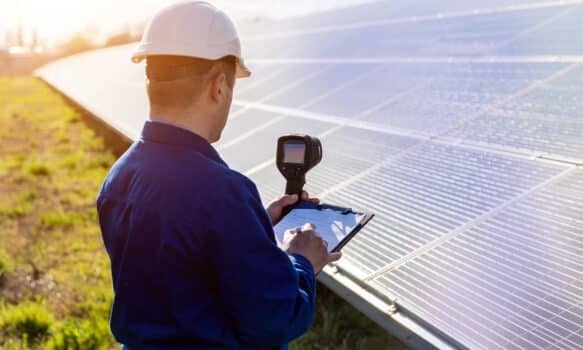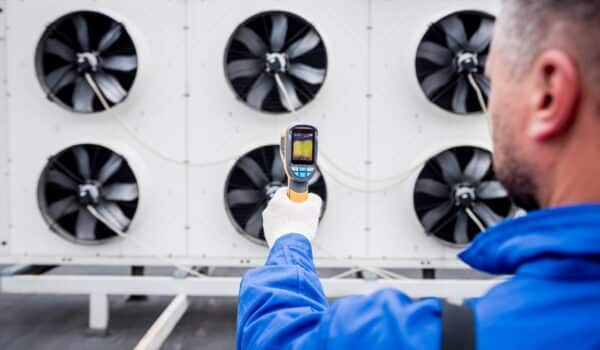While a thermal camera is typically used commercially in security systems, drones, fire detection, etc., hobbyists can look for affordable options or accessories to explore the technology via smartphone apps.
Unlike some decades ago, thermal imaging is no longer rocket science. With the best thermal imaging camera, you can enjoy “heat-sensing vision” and apply thermography in your next big project!
In fact, these handheld devices are a must-have for engineers for detecting regions of excessive temperature or wasted heat energy. So, you can already understand that thermography has many applications.
But before proceeding on the steps to use a thermal imaging camera, let’s get back to basics…
What Is A Thermal Image?

Also known as a thermogram, a thermal image is a pictorial representation of a scene depicting the thermal radiation emitted by the objects in the picture.
Thermal images are helpful in analyzing the temperature (or relative temperature) of an object. As a result, thermal imaging technology is used to measure the temperatures of objects remotely and, of course, feel “cool” by being able to see in the dark!
What Is A Thermal Camera?
Thermal cameras are devices designed to identify heat energy. With an integrated visual display and thermal imaging sensors on the lens, these cameras can detect potential thermal insulation gaps or overheating components.
When directed at an area or object, a thermal camera detects the “invisible” infrared spectrum, allowing users to see the wavelengths between microwaves and visible light. Essentially, in an electromagnetic spectrum, visible light forms only a small portion, which is what we see with the naked eye.
Modern infrared cameras render the “invisible” infrared spectrum as a color map. As some of you may have guessed, warmer parts of a thermal image are shown as oranges, yellows, and reds.
On the contrary, cooler portions are depicted in blues and purples. Anything that appears green is around room temperature.
Notably, infrared cameras are used to identify heat signatures in extremely dark environments since they measure infrared radiation and not visible light.
Thermal Imaging Cameras – How It All Started
With the advent of thermal technology, handheld thermal cameras (a.k.a. thermal detection cameras, heat cameras, infrared cameras, etc.) have become widely accessible for professionals and enthusiasts alike. But it was British-German astronomer William Herschel who established the principle of thermal imaging more than two centuries ago!
In February 1800, Herschel discovered the concept of infrared with a prism. By putting a thermometer past the red light, he recognized the presence of an “invisible world,” the light being much warmer than the ones present in visible light. It is this “not visible” light on the electromagnetic spectrum that is called infrared radiation.
Herschel’s discovery was then used in many thermocouple-type modules. Later, other engineers, inventors, and physicists developed his findings…
- Hungarian polymath Kálmán Tihanyi produced thermal imaging technologies and innovated cathode ray TV technology
- The “night vision” infrared camera is the brainchild of Tihanyi, invented in 1929 for British anti-aircraft defenses
- In the 1970s, solid-state thermal imaging arrays and modern hybridized single-crystal-slice imaging devices were developed
- Thereafter, handled units were invented, which, unlike previous mechanical versions, were more versatile
- Until the 2000s, thermal cameras were still not affordable enough for civil uses
- Eventually, the applications of thermal imaging cameras were realized in environmental control, architecture analysis, autopiloting systems, and more
- With WiFi connectivity, microcircuitry, and smart sensors becoming more affordable, thermal video cameras have gained popularity among professionals as well as hobbyists
How Do Thermal Cameras Work?
A thermal imaging camera identifies and measures the infrared radiation emitted by an object. Basically, the camera captures an object’s “heat signature.” The thermal camera is equipped with a lens that recognizes IR frequencies and pushes them through a special sensor array. As a result, the infrared energy is converted into an electronic signal.
Then the signals are transferred to the processor located in the main device. They are further converted into a color map of different temperature values using different algorithms. This map is sent to the screen for rendering.
Most thermal cameras are equipped appropriately for a standard shooting mode as well. This mode works like regular cameras, wherein the lens captures the visible light spectrum. As such, the user can compare the two shots taken in IR and normal mode. Doing so helps professionals identify problem areas in a particular setting.
Common Uses Of Thermal Imaging Cameras
1. Thermal Cameras For Apple And Android Phones
While both Android and iOS devices boast plenty of “infrared” and “thermal” photo editing apps, they don’t offer the “real deal.” The most you get is a fancy filter that simply mimics thermal detection imaging.
So, if you want to experience the process of thermal imagers on your phone, we recommend getting an auxiliary thermal camera device. Such devices need to be attached to the smartphone and used along with an app. Although they are not cheap, splurging on these accessories is currently the only way to perform heat detection with a smartphone.
2. Thermal Security Cameras
Nowadays, every commercial location uses security cameras of different kinds. However, more recently, thermal imaging surveillance equipment has become the norm since they offer better protection. Plus, they perform well in darker areas with low visibility, thereby offering better identification.
Thermal security cameras are also ideal for removing “visual camouflage” like dense shrubs and trees near most commercial buildings. Not to forget, CCTV cameras offering thermal readings ensure reduced chances of false alarms.
3. Thermal Cameras For Drones
Remotely piloted drones (UAVs) use thermal conductivity to capture enhanced footage in difficult conditions. As such, thermal imaging is a great investment for videography and photography enthusiasts.
4. Industrial Infrared Cameras
Cameras used in below-ground applications such as mining, areas subject to explosive gasses, and around high volumes of airborne dust particles use thermal energy for better application. So, if you require an industrial IR camera, we recommend checking with suppliers and ensuring the manufacturing guidelines conform to all relevant standards.
5. Night Vision Cameras
You can choose between night vision cameras and thermal imaging IR cameras for capturing footage in low light. However, both these units use different technologies.
To begin with, night vision cameras rely on some amount of ambient light to capture images in relatively dark environments. Offering a grainy green-and-white night-time display, these cameras, unfortunately, cannot capture much in completely dark areas.
However, when equipped with infrared illumination, these night vision cameras provide a greater wavelength of amplifiable electromagnetic signals. As such, the sensor captures objects and scenes which are otherwise invisible to the human eye.
Moreover, night vision cameras are ideal for hobbyists who prefer a more naturalistic picture quality. But do keep in mind that they are not as effective as thermal cameras in foggy, dusty conditions.
6. Thermal Imaging Cameras For Wildlife
Nowadays, a thermal camera with smart sensors is left in the wild as it automatically triggers to capture wild nocturnal creatures. As a result, professional wildlife photographers can observe hard-to-spot species and their behaviors more comprehensively.
7. Thermal Imaging Cameras For Fire Detection
Thermal cameras work effectively in low visibility conditions to detect survivors, hotspots, still-burning fires, potential sources of ignition, and more.
8. Thermal Imagers In Marine Cameras
A thermal camera has multiple marine applications, like in collision detection systems. Although underwater thermal imaging is not quite effective, seagoing vessels nowadays are almost always equipped with thermographic cameras with marine-grade specifications.
Cost Of A Thermal Camera

Now, you must be wondering why such a useful device is not getting any cheaper. For starters, our expectation of the price may be way off the actual cost of thermal cameras. This is partly because we are familiar with regular cameras, and we expect all other cameras to bear a similar price tag.
Too bad that’s not how pricing works! Right from the technology behind the camera to their volume of production, thermal cameras and visible light cameras are poles apart in every aspect. So, let’s take a deeper look into some factors that make thermal imaging cameras a pricey pick.
1. Manufacturing
Thermal cameras require high-quality germanium glass lenses. Plus, they require a focal plane array (FPA) which is a type of bolometer, along with a circuit board.
Clearly, the technology and materials used for manufacturing a thermal camera are much more sophisticated than those used in regular cameras. This adds to the overall cost of production of thermal imaging cameras.
2. Protection
Adding to the previous point, conserving thermal energy and projecting it to specific sensors requires lenses and windows. The type of lenses used in a thermal imager also needs to be opaque. And as you may have already assumed, these lenses require more of those “sophisticated” materials to remain durable and effective.
3. Calibration
In thermal imagers, the sensors required for each and every pixel is non-uniformly responsive. Consequently, each sensor consumes additional processing power to generate a uniform heat signature, which requires calibration.
This process takes additional testing rounds, which take up more time and effort, and hence, you end up paying more for such thermal cameras.
How To Trick A Thermal Imaging Camera?
As Arthur C. Clarke once said, “Any sufficiently advanced technology is indistinguishable from magic.” Or so we think until we fully understand how it works. After all, technology is manmade, and it only takes so much for another human to understand, replicate, or even misuse it.
So, here are a few ways to trick a thermal imaging camera to further understand its working…
1. Allow Equipment And Vehicles To Cool Down
By now, you already know that thermal cameras work by detecting the heat signatures of objects and their surrounding areas. Hence, you can try cooling down your vehicles, exhaust systems, motors, etc., by waiting for some time or covering them with a wool blanket.
You could even experiment by placing vegetation on a poncho liner and adding an aluminized combat casualty blanket for a more effective cover. We also recommend making the edges of the cover uneven. Clean-cut edges may seem fishy since naturally occurring straight lines are uncommon.
2. Maintain Distance
Just like with any other camera, the farther you are from the lens, the more difficult it is to detect you. As such, you can use distance to trick a thermal imager and degrade the contrast of temperature between you and the surrounding areas.
3. Take Advantage Of Shade
Thanks to the concept of solar loading, brightly lit areas are hot spots for thermal inspections. Basically, when the sunlight hits an object/equipment, it absorbs and retains the heat, thereby creating more temperature difference.
However, if the object/equipment was kept in the shade, its temperature almost matches the surrounding environment, making it difficult to capture by a thermal or infrared camera.
4. Change Your Appearance And Behavior
Detecting a human body is easy, even for a thermal camera. There’s a round head, the hands and legs that are usually erect, and the unmistakable human gait. Hence, changing your appearance and mannerisms can trick thermal devices to some extent. You can even try staying still and playing dead!
5. Experiment In Hard-to-spot Regions
Since thermal cameras cannot see through walls, objects, and thick vegetation, try experimenting in areas that are hard to spot. For instance, hide in a deep hole, or explore a forest or mountainous terrain.
How To Read A Thermal Imaging Camera?
1. IR Resolution
Knowing the resolution of a thermal camera is the basic requirement for reading a thermal imaging camera. It depicts the number of pixels of the device, thereby portraying the clarity of the thermal image. The three standard resolutions available in thermal cameras are:
- 640 x 480 (307 x 200 pixels – High resolution)
- 320 x 240 (76,800 pixels – Medium resolution)
- <160 x 120 (19,600 pixels – Low resolution)
2. Field Of View
The lens of a thermal camera illustrates its field of view. The sensor size and distance from the object also determine the area the imager sees. Note that the field of view is denoted in angular degrees and hence, should not be mistaken as the temperature of the captured object or environment.
3. Palette
Thermal images can be taken in different color schemes, such as:
- Blue-red
- Gray
- High-contrast
- Ironbow
- Amber
4. Thermal Sensitivity (Noise Equivalent Temperature Difference)
Thermal sensitivity denotes how sensitive the device is to temperature differences. The amount of sensitivity is directly proportional to the clarity of the subject being captured.
Noise Equivalent Temperature Difference (NETD) is used to express thermal sensitivity of a thermal camera.
5. Emissivity
This defines how well the pictured object is releasing infrared radiation. So, on a scale of 0-1, 0 depicts a perfect radiator, and 1 depicts no radiation at all.
6. Accuracy
The accuracy of a thermal camera denotes how close its reading will be to the actual value.
7. Temperature Measuring Range
This range portrays the device’s range within which you can expect correct temperature measurements. The specifications sheet of a thermal camera mentions its temperature range (minimum and maximum temperature).
8. Distance-to-Spot Ratio
The relationship between the thermal camera’s distance from the desired area and the area’s size is the distance-to-spot ratio. As per the ratio, the size changes as the distance increases and decreases.
9. Spatial Resolution/Instantaneous Field of View (IFOV)
This parameter is used to measure the smallest detail within the field of view of a thermal camera. It is measured in mRads; the smaller the number, the greater clarity you get.

How To Use A Thermal Imaging Camera Conclusion
That said, we have come to the end of this extensive guide to using thermal imaging cameras. We also discussed its practical applications and how to trick and read the devices. As such, we hope that you will be able to choose a suitable thermal camera for professional or casual use.
We recommend opting for a reputed brand like Adiance or Teledyne FLIR, checking the resolution offered along with other specifications, and of course, ensuring the price suits your budget.


